Quickbase is a no-code development platform for building internal apps for business processes. It caters to enterprise business users, which make up more than 70% of their customer base. Quickbase allows users to create simple apps for data entry and management, as well as to support business processes like order management and field service operations.
Bubble’s no-code platform has been used to build and scale nearly 5 million applications over the last 10+ years, with startups and enterprises alike choosing to build on Bubble. Bubble’s a proven, scalable solution for building everything from internal tools and enterprise solutions to AI-powered apps, SaaS products, marketplaces, and more.
Either platform may work for your project, but Bubble has the edge when it comes to:
- Customization
- Use-case versatility
- Learning curve
- Cost
- Ecosystem
Of course, we are Bubble, and so naturally, we’re big fans of our own platform. That’s why we tapped the wider no-code community to find out what mattered most to them when choosing a platform. Then we used their responses to develop a rubric that more objectively compares Bubble to solutions like Quickbase.
In this article, we’ll show you how these two platforms stack up — and you’ll see why no matter what you’re trying to build, Bubble is a fantastic option. If you want to learn more about the process of choosing the right tech for your use case, check out our full buyer’s guide to 23 different no-code development platforms.
Quickbase vs. Bubble: At-a-glance comparison
Let’s start with a high-level overview of how Bubble and Quickbase compare.
| Quickbase | Bubble | |
|---|---|---|
| Common use cases | Quickbase is a popular solution for internal tools and data management for enterprises. | Bubble is one of the fastest, easiest ways to build enterprise or customer-facing apps of any kind, from internal tools and data management dashboards, to SaaS tools and more. |
| Where they shine | Quickbase is well-known for creating internal apps to manage data entry and analysis, alongside business processes. | Bubble’s customization, versatility, and moderate learning curve gives anyone the ability to build custom, complex, powerful apps that meet their team's needs. |
| Overall score | ⭐⭐⭐💫 (3.39) | ⭐⭐⭐⭐ (4.00) |
| Use-case versatility | 🟩🟩🟩🟩⬛ | 🟩🟩🟩🟩🟩 |
| Full-stack coverage | 🟩🟩🟩🟩🟩 | 🟩🟩🟩🟩🟩 |
| Performance | 🟩🟩🟩🟩🟩 | 🟩🟩🟩🟩⬛ |
| Ecosystem | 🟨🟨🟨⬛⬛ | 🟩🟩🟩🟩⬛ |
| Cost | 🟥⬛⬛⬛⬛ | 🟨🟨🟨⬛⬛ |
| Customizability | 🟥🟥⬛⬛⬛ | 🟩🟩🟩🟩⬛ |
| Compliance | 🟩🟩🟩🟩🟩 | 🟩🟩🟩🟩⬛ |
| Code ownership | 🟨🟨🟨⬛⬛ | 🟨🟨🟨⬛⬛ |
| Learning curve | 🟥🟥⬛⬛⬛ | 🟨🟨🟨⬛⬛ |
| Resources | 🟨🟨🟨⬛⬛ | 🟩🟩🟩🟩⬛ |
| Community | 🟩🟩🟩🟩⬛ | 🟩🟩🟩🟩🟩 |
We wanted to compare these platforms based on what matters most to actual no-code developers — so we asked them. In our 2024 State of No-Code Development Survey, more than 350 no-code founders, developers, freelancers, and hobbyists rated the importance of 17 factors when choosing a no-code builder. We developed these categories using their feedback.
In the fall of 2024, we scored Bubble and Quickbase from 1–5 in each of these areas, with 5 being the best score. Each score had specific requirements, and we’ll explain more about those below.
We also gave each platform an overall score using a weighted average. This was based on how important the category was to no-code developers in the survey. Here’s how Bubble and Quickbase compared.
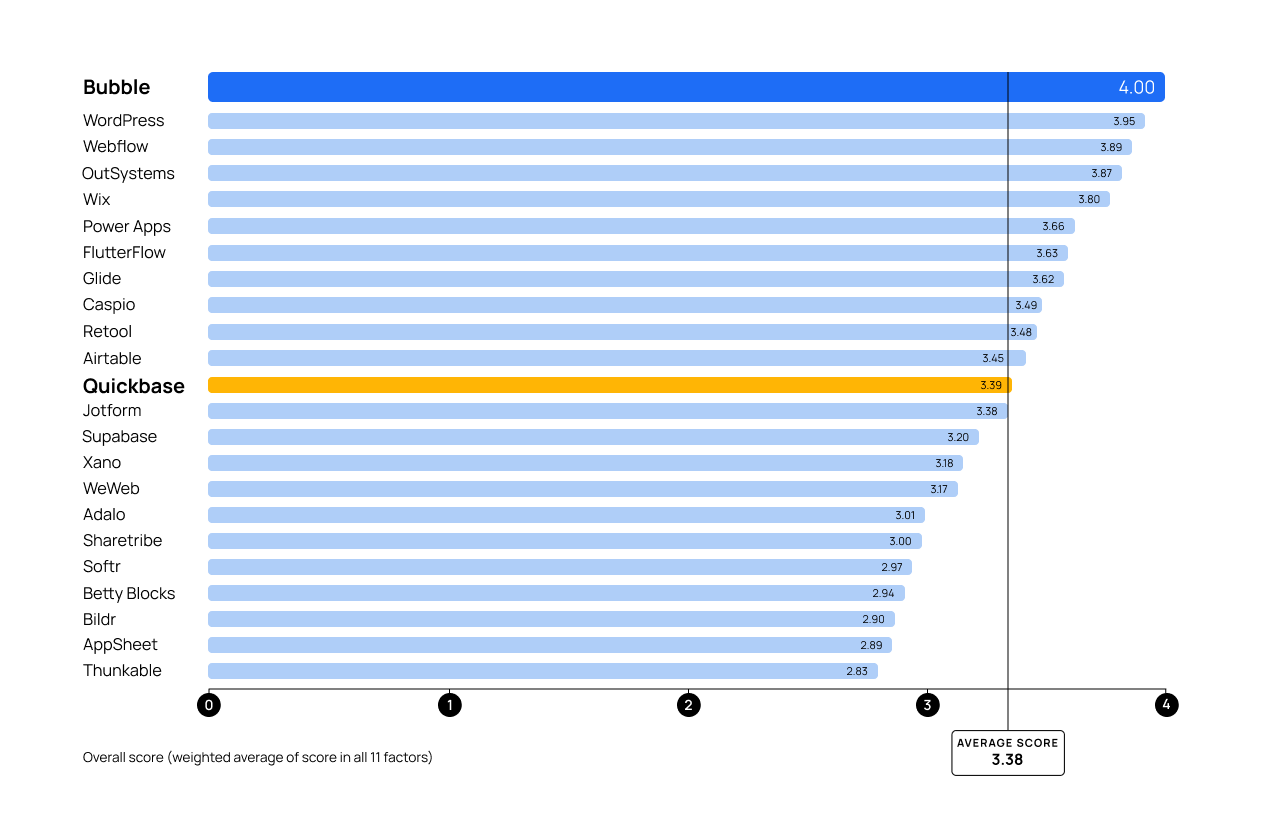
Quickbase vs. Bubble on use-case versatility
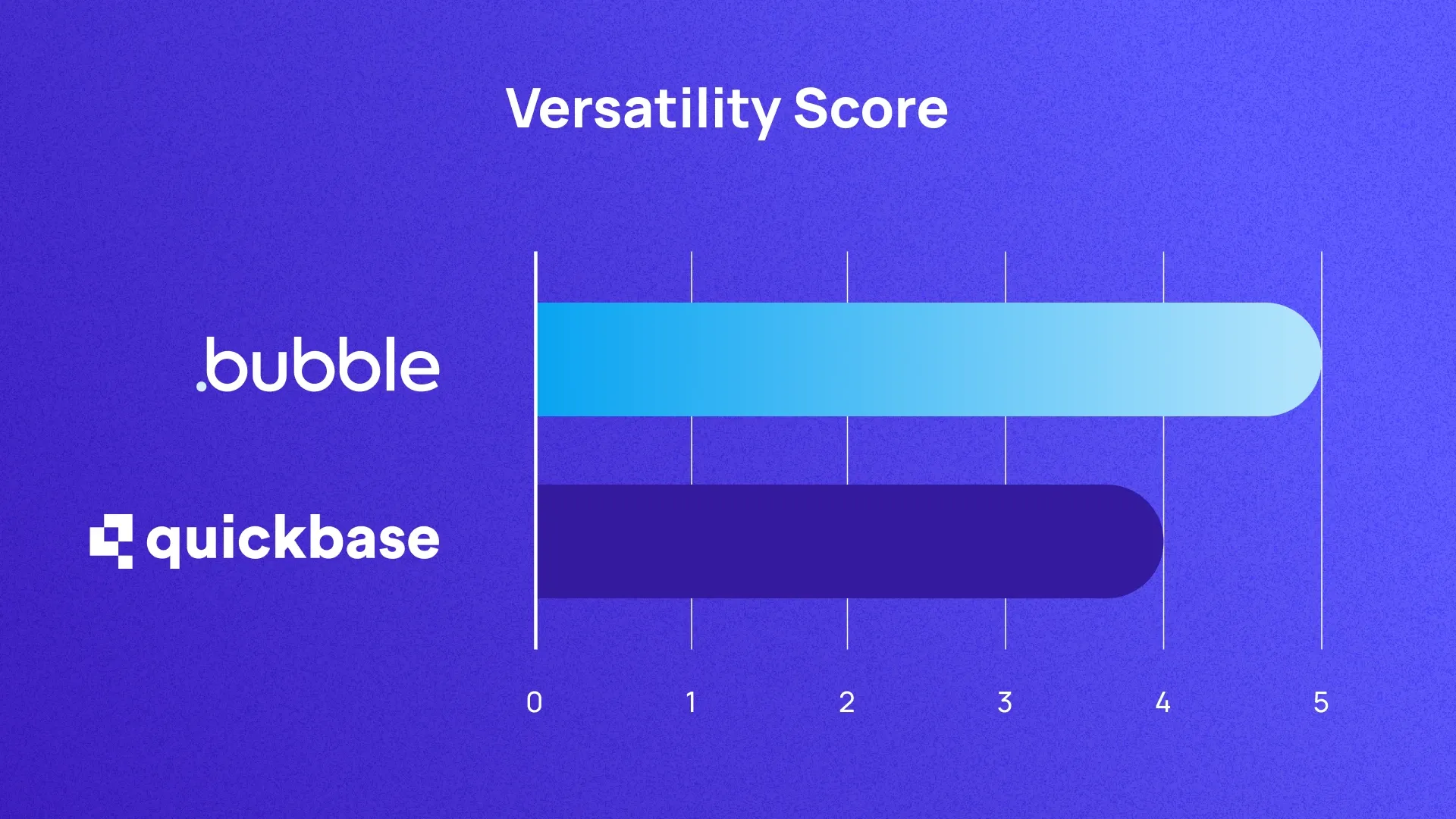
When a platform is mostly used for a specific purpose, it tends to be really good for that purpose, and really difficult to use for other purposes. If you’re looking for a tool for specific use cases, you’re in luck! But if you’re looking for a tool that can help you accomplish lots of different projects, you need something flexible and versatile.
Our scores for use-case versatility try to take this into account, rating each platform based on the range of use cases most people use them for.
Bottom line: Quickbase offers some versatility in use cases and industry, but cost and functionality limits how versatile the platform can really be. Bubble offers complete flexibility and versatility to build anything you want, for any industry.
| Score | Criteria |
|---|---|
| 1 | Not particularly well-known or well-perceived by the market for any use cases |
| 2 | Narrow set of use cases as perceived by the market |
| 3 | Use-case versatility across app types or industries, but not both. |
| 4 | Use-case versatility across either app types or industries, with some use-case versatility in the other category |
| 5 | Shown to be proficiently versatile across both app types and industries |
How Quickbase stacks up: Quickbase offers industry versatility, but only some versatility across app types.
In general, Quickbase is designed for internal, enterprise business tools and apps. The primary use cases include tracking, managing, and analyzing business processes, like CRM and sales, project management, or management of field services, deliveries, work orders, compliance, and other types of business processes.
You could expand a bit beyond that use case and make client portals or other types of business tools, but it can get complex quickly.
Worth noting, as well, that Quickbase’s pricing makes it cost-prohibitive for all except large, enterprise teams. As a result, it focuses on industries like construction, manufacturing, government, legal, and property management — regulated enterprise industries with a lot of moving pieces. Teams outside these industries could use Quickbase too, but you’ll notice that the design and features are catered toward these types of teams.
Quickbase’s versatility score: 4/5
How Bubble compares: By contrast, Bubble is one of the most flexible and versatile no-code platforms on the market today. With nearly five million apps created on Bubble, you can build anything you imagine.
Enterprise teams in any industry, as well as individuals, agencies, and hobbyists, use Bubble to build and power apps of all kinds. For example, builders have used Bubble to create:
- An enterprise-scale field and operations tracking solution for La Metro
- An AI-powered customer service SaaS product
- Customer-facing, enterprise solutions and portals for Seagate
- A marketplace to match per-diem doctors with hospitals
- A personalized health and wellness e-commerce business
- A custom ERP and HR system and portal for Athena
- And so much more!
On Bubble, you have the flexibility to create anything, from websites to web apps and native mobile apps.
Bubble’s versatility score: 5/5
Quickbase vs. Bubble on full-stack coverage
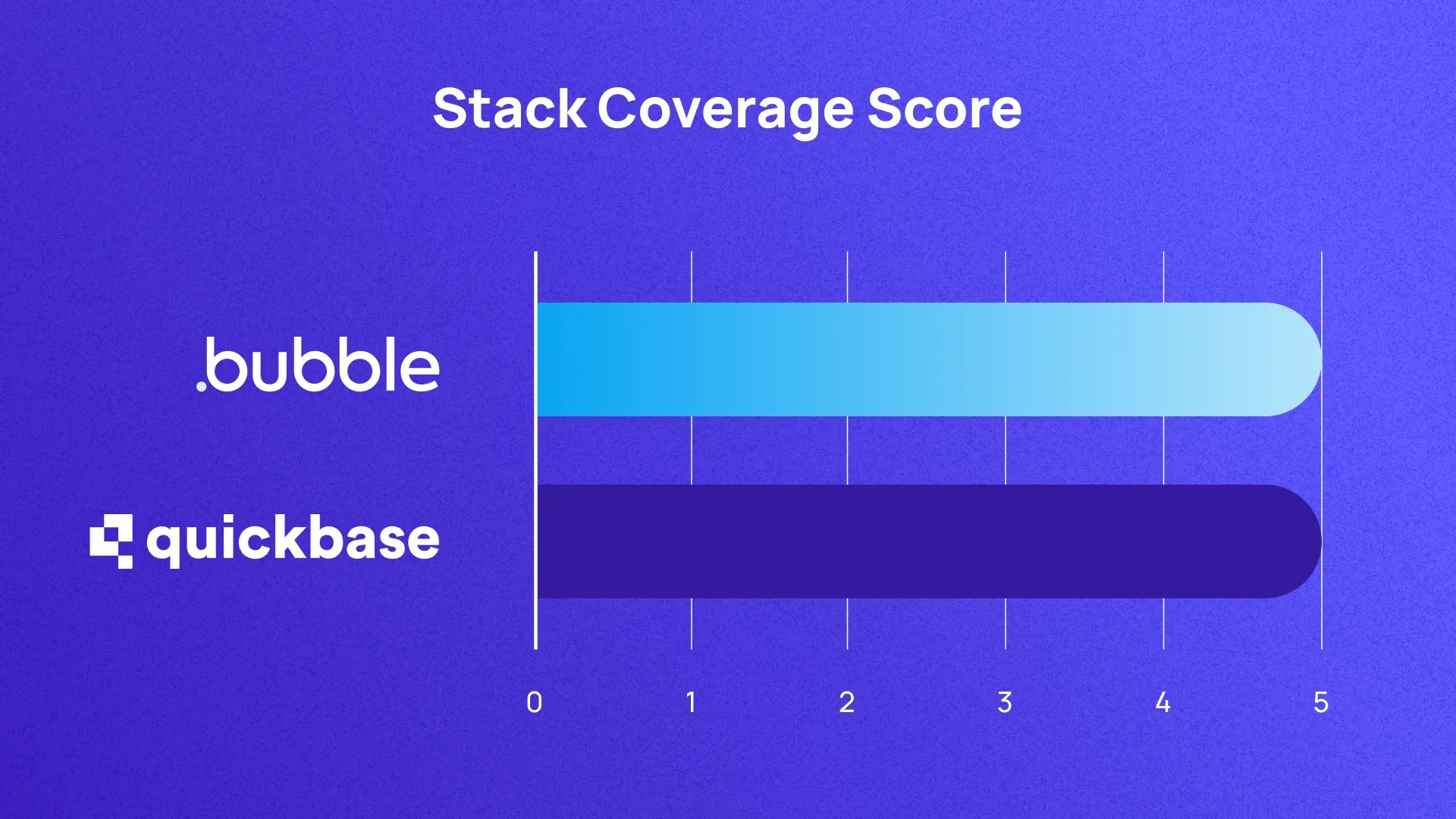
When it comes to software development, there are three main pieces of your “tech stack” you need to cover: design (the frontend), data (the backend), and logic (the workflows that connect those two pieces and make your app work). However, many visual development platforms only focus on one or two of these elements, leaving you cobbling together tools to build a complete app.Our scoring criteria for this category focuses on how much of the development process the platform lets users access — in other words, how close the platform is to being a “full stack” solution.
Bottom line: Bubble and Quickbase both offer full-stack solutions, but Bubble offers a stronger frontend solution.
| Score | Criteria |
|---|---|
| 1 | Capabilities in one area: design, data, or logic |
| 2 | Capabilities in one area, gives user limited access to another |
| 3 | Capabilities in two areas |
| 4 | Capabilities in two areas, gives user limited access to the third |
| 5 | Full-stack: Capabilities in design, data, and logic |
How Quickbase stacks up: Quickbase is a full-stack solution, offering design, data, and logic capabilities. There’s a few caveats to keep in mind, though. For one, adding logic in Quickbase requires you to learn Quickbase’s formula language, or use Python for custom code — it’s not true no-code logic.
Quickbase also isn’t as strong for a frontend solution. Design and UI customization is weak, so it tends to be best only for internal tools. Even then, the UX can be tough to customize, and your apps for enterprise usage may not be as user-friendly as you’d like them to be.
Where Quickbase shines is with their backend databases. Although it has some limitations, they offer advanced database functionality, ample customization, and strong database performance. Some users report Quickbase can scale to up to a million records in databases.
Quickbase’s stack coverage score: 5/5
How Bubble compares: Bubble is a full-stack, no-code development platform that offers strong frontend, backend, and logic. You never have to combine it with another solution, or pay for more than one platform.
Of course, if you’re already using another solution and are looking to combine it with something else, or you’re looking to fill gaps in your tech stack, Bubble can do that too. But you aren’t required to manage separate platforms to build a completely customized, fully-functional app on Bubble.
Bubble’s stack coverage score: 5/5
Quickbase vs. Bubble on performance
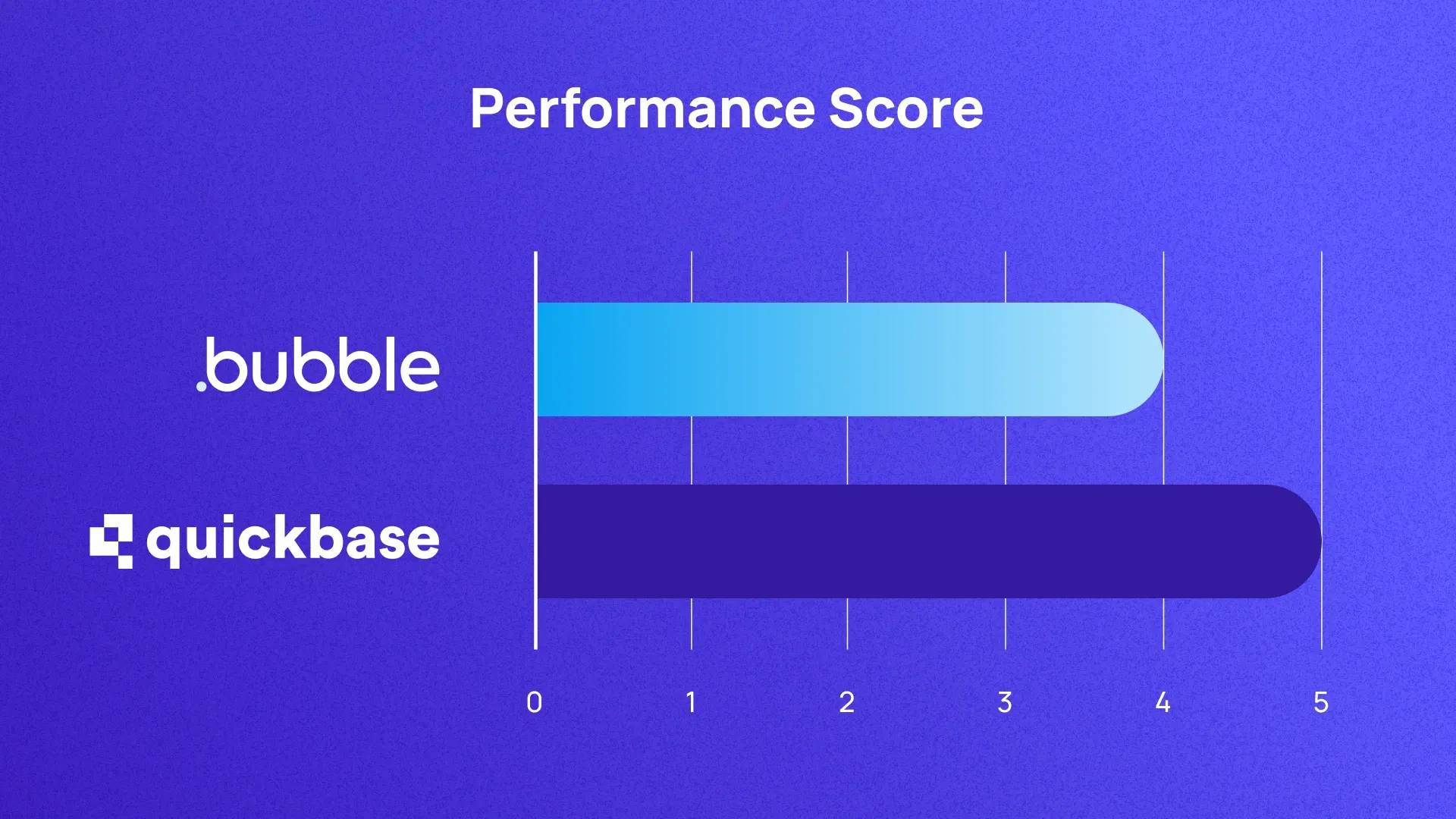
Technical performance and reliability will make a huge difference in your experience with a platform. After all, your own app can only be as stable as the platform it’s built on.
And if your no-code platform doesn’t provide much information or transparency on outages when they occur, your own app may be down for a while without much you can do about it.
When comparing Bubble and Quickbase, we took into account how the platform performs, especially as you scale up server demand. That is, can the platform grow with you, or does performance take a hit when your user base grows too large?
Bottom line: Bubble and Quickbase both offer reliable, stable platforms, and provide quick and transparent information about issues when they do occur.
| Score | Criteria |
|---|---|
| 1 | Frequent outages |
| 2 | Outages scale with user growth and/or company has no status page |
| 3 | Infrequent outages, but communicated with limited transparency to the user or sporadic outages, but quickly and transparently addressed |
| 4 | Infrequent outages, with any that do occur quickly and transparently addressed |
| 5 | Rare outages |
How Quickbase stacks up: Quickbase offers stable, reliable performance, with strong uptimes in recent months. Outages overall are rare. They also have a well-organized and detailed status page, which provides details about recent performance, any planned maintenance or downtime, any issues — and their status — and so on.
Quickbase’s performance score: 5/5
How Bubble compares: Bubble also offers strong and steady performance. Bubble rarely experiences outages, especially ones that affect a large number of users. But if they do happen, our team does two things especially well:
- We detect and resolve the issue quickly to get you back online.
- We clearly communicate what’s happening and what we’re doing about it, so you’re never in the dark.
We continue to invest heavily in our performance and infrastructure, as we know that our systems directly impact yours. If you’re experiencing an issue, start by checking Bubble’s status page. You can also keep up to date on outages via @BubbleStatus on X and the forum.
Bubble’s performance score: 4/5
Quickbase vs. Bubble on ecosystem
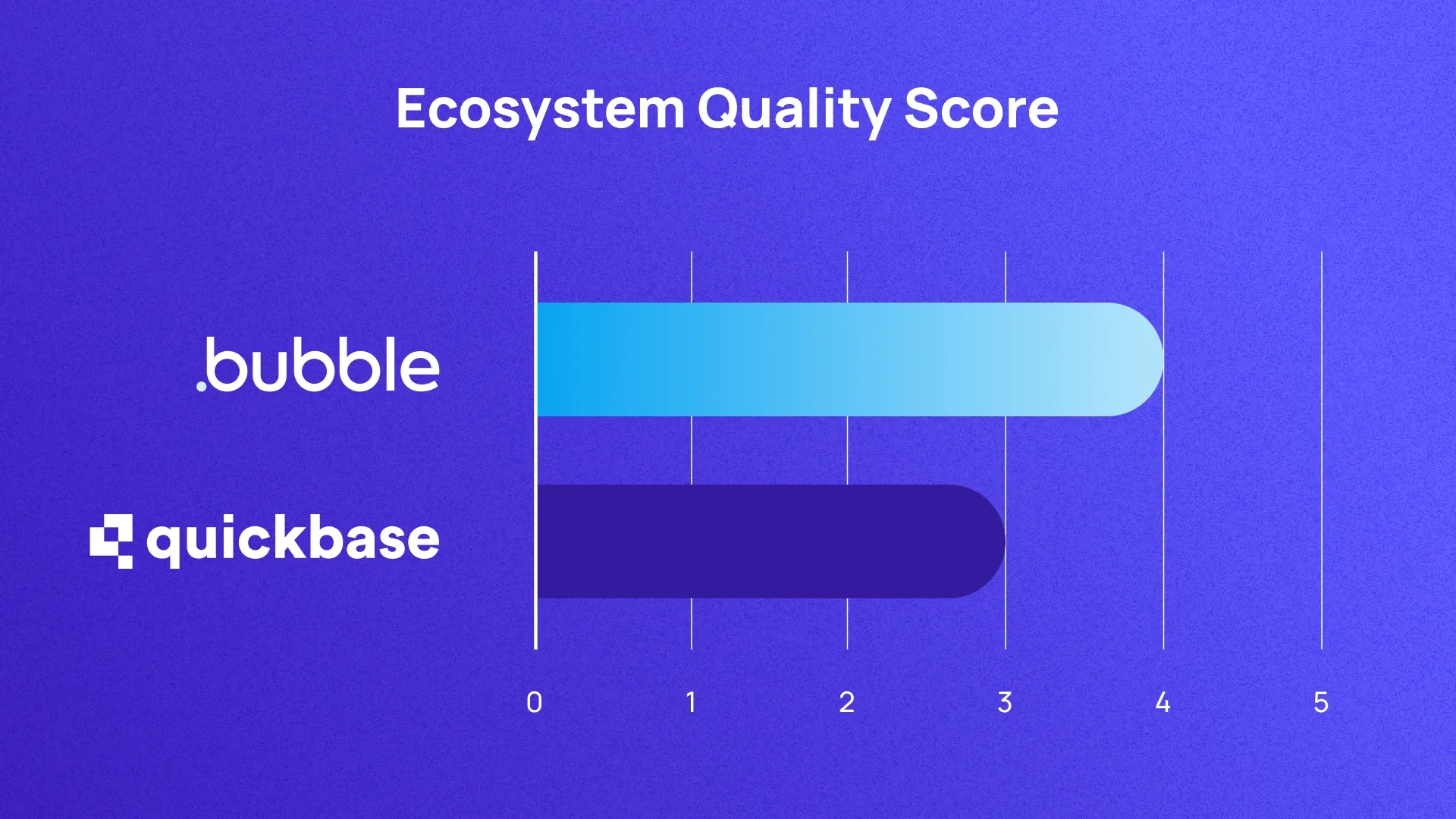
The ecosystem around your platform is almost as important as the platform itself. A robust, accessible, and easy-to-use ecosystem of third-party tools, services, plugins, partnerships, and so on can help you extend the capabilities of your app.
Our ecosystem quality scores are based on what third-party services a vendor offers, the third-party products that have been created, how accessible they are, and what partnerships they have.
Bottom line: Bubble offers a robust and accessible ecosystem. Quickbase has a strong ecosystem too, but some of the main plugins and integrations are paywalled behind higher-tier plans.
| Score | Criteria |
|---|---|
| 1 | Minimal third-party services that are challenging to use |
| 2 | Minimal third-party services, but they’re easier to use |
| 3 | Robust third-party services, but they’re challenging to use |
| 4 | Strong strategic partnerships; robust third-party services, but not perfectly seamless |
| 5 | Strong strategic partnerships; robust third-party services that are easy to use |
How Quickbase stacks up: Quickbase offers a decent ecosystem, but it’s not as accessible as other no-code tools. First, the pros: Quickbase offers a pretty solid set of plugins called “add-ons,” which can help you extend the capabilities of your app. They also offer a decent number and variety of integrations to help you connect your Quickbase app(s) to other tools in your tech stack. You’ll also find hundreds of ready-to-use templates. These are mostly centered around tools to help manage business processes for enterprise users.
The cons: Some of Quickbase’s integrations are paywalled behind higher-tier plans, so even if you’re paying for a monthly plan, you still might not be able to integrate all the tools in your tech stack. It’s definitely worth checking if you’ll be able to integrate everything you need before committing to the platform.
For example, even though Quickbase is often used for project management and business workflow apps, integrations like Jira, Asana, Mailchimp, Docusign, Salesforce, and others aren’t available for lower tiers.
Quickbase’s ecosystem score: 3/5
How Bubble compares: Bubble offers a robust and easy-to-use ecosystem that gives you everything you need to extend your app’s functionality, connect it to other tools in your tech stack, and more.
You’ll find thousands of plugins and integrations which are easy to use — just a few clicks and you’ll be all set up for most plugins. This way, you don’t need to code any integrations yourself (unless you want to).
Plus, there’s a massive collection of templates that’s growing all the time as the Bubble community adds to it. If you’re looking for a faster way to develop the layouts, designs, workflows, pages, and features you need — check out the template and component library.
Bubble also has strategic partnerships with startup programs and universities, including Microsoft For Startups, Harvard University, and Columbia University.Plus, our agency database gives you easy access to agencies that use Bubble by experience, services, cost, language, and region. If you’re looking to bring on support in building or managing your Bubble app(s), you can quickly find a partner that’s right for your project and submit a request for proposal right on our site.
Bubble’s ecosystem score: 5/5
Quickbase vs. Bubble on cost
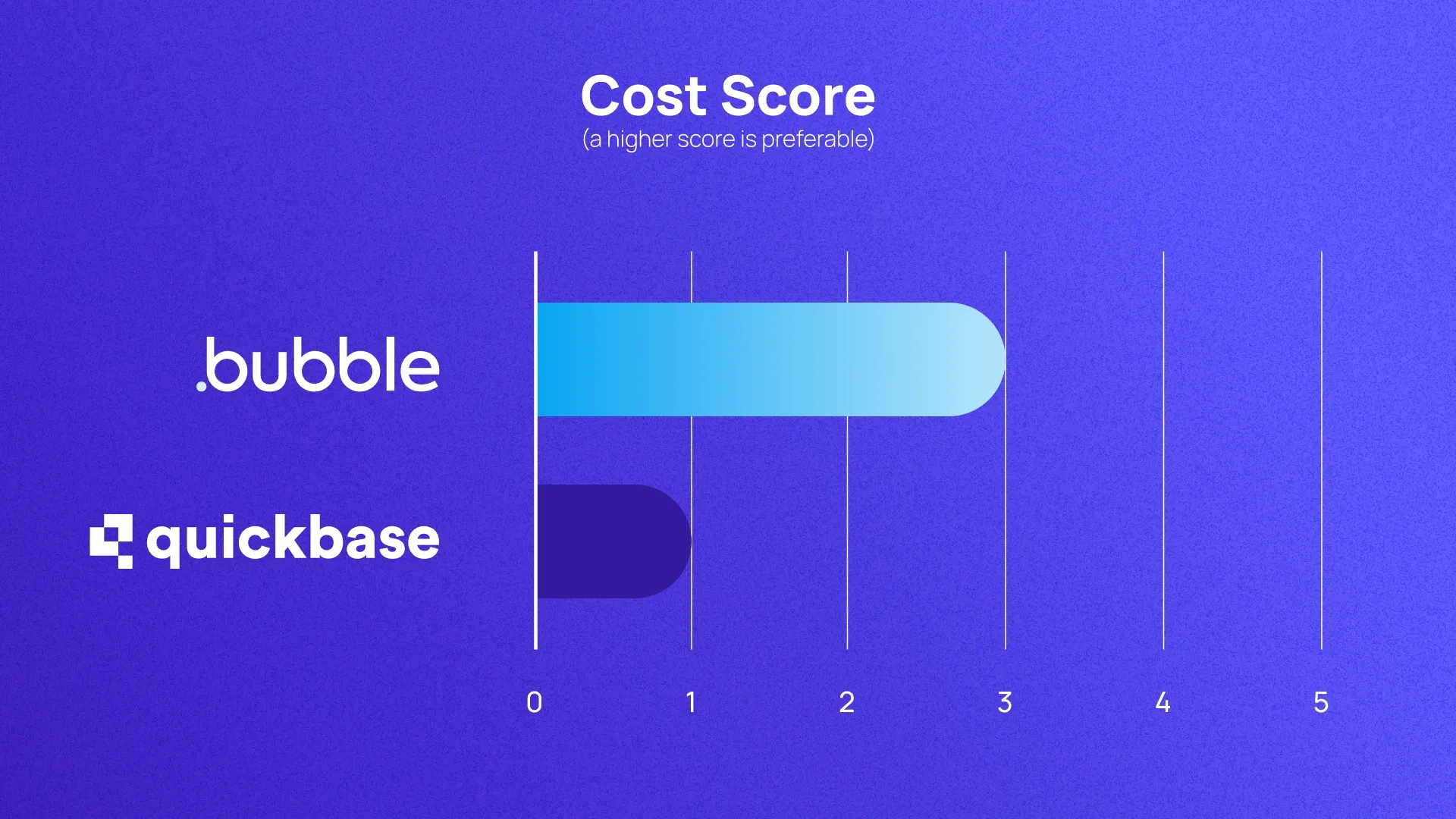
The cost grades we gave Quickbase and Bubble consider the cost of using the tool, with higher scores reflecting lower costs. While there are many factors that impact cost, we primarily took into account the pricing model, the platform’s price, and how much free access the vendor allows.
Bottom line: Quickbase is an expensive, enterprise-focused solution, with plans effectively starting at $700 per month. Bubble offers plans for all app and team sizes, with plans starting at $29 per month.
| Score | Criteria |
|---|---|
| 1 | No free tier |
| 2 | Free tier, deployment on custom domain costs more than $50 per month |
| 3 | Free tier, deployment on custom domain costs less than $50 per month |
| 4 | Free tier, deployment on custom domain costs less than $10 per month |
| 5 | Free deployment on custom domain |
How Quickbase stacks up: Quickbase is designed for enterprise teams, which really shows up in their pricing. There isn’t a free plan, although you can take advantage of a 30-day free trial before you commit.
After that, monthly plans start at $35 per user per month, but the lowest tier (the “Team” plan) has a minimum of 20 users. As a result, plans actually start at around $700 per month.
Quickbase’s cost score: 1/5
How Bubble compares: By contrast, Bubble’s pricing makes it accessible to everyone, from hobbyists to startups and growing businesses and large enterprises alike.
You can build for free as long as you need, up until you’re ready for launch. Once you launch, you’ll switch to a paid monthly plan, with the monthly plan on a per-app basis, rather than a per-user basis. Plan costs vary based on the workload demand of your software and the capabilities you need.
Put simply: Bubble servers have to scale with your app as it grows, and that means pricing does, too. Plans start at just $29 a month per app.
Bubble’s cost score: 3/5
Quickbase vs. Bubble on customizability
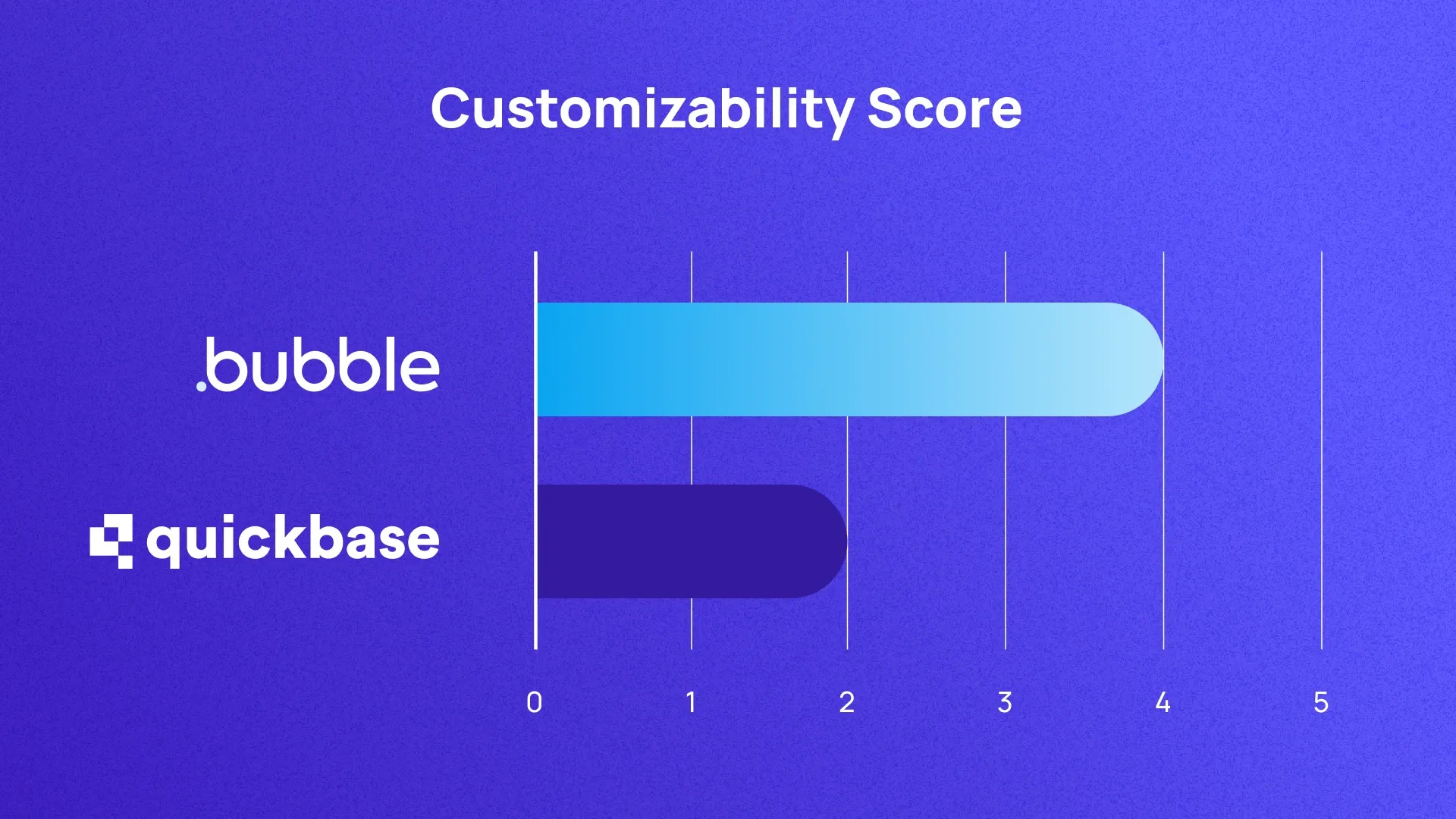
Of course, every no-code platform will offer some level of customization. But how much can be customized — and how easy that is to do — will vary a lot from platform to platform.
Some platforms don’t allow much customization at all. Many tools allow customization, but through custom code (which kind of defeats the purpose of it being a no-code platform). The best platforms allow ample customization through the visual editor, and may even provide AI features to make customization even simpler.
In this comparison, our customizability scores are based on how flexible a platform is — both in terms of what you can build with it, and how easy it is to add new features throughout your software’s lifecycle. We also considered whether the platform makes customization easier with AI.
Bottom line: Bubble offers far superior customization options compared to Quickbase. Quickbase offers customization for backend databases, but frontend customization is very limited.
| Score | Criteria |
|---|---|
| 1 | Minimal ability to customize frontend, minimal ability to add new functionality, high level of difficulty to build beyond templates |
| 2 | Customizable frontend, minimal ability to add new functionality, limited generative AI assistance |
| 3 | Customizable frontend, open to adding new functionality, robust frontend AI use cases |
| 4 | Everything from 3, plus AI-generated logic and data schema |
| 5 | Everything from 4, plus conversational editing that allows for entire AI-generated apps |
How Quickbase stacks up: Quickbase offers some customizability, but it can be difficult to use, and limited in scope.
You’ll find the most customization options in the backend. Quickbase offers a flexible database with advanced customization options. Customization options are more limited for logic and workflows. You have some customization available, but there are also a lot of limitations that you’ll have to use custom code or other workarounds to avoid.
The frontend is the most rigid and has the fewest customization options. Many users complain that it’s very difficult to create custom UI components, or in some cases, that you simply can’t do what you want in terms of design at all. While you can customize the basics like fonts, colors, and so on, you’re limited in terms of components, layouts, and so on. Some users complain that Quickbase apps always have that “enterprise” feel in terms of frontend design.
There are also limits to how much you can adjust via the visual builder. For many customizations beyond the basics, you’ll have to use custom code, which is obviously more difficult to learn and use.
In short: Quickbase offers some customization options, especially on the backend, but provides a limited ability to create truly custom functionality. It also has very little customization options for the frontend design.
Quickbase’s customizability score: 2/5
How Bubble compares: Customization is an area where Bubble really shines and is one of the platform’s greatest strengths.
You can build just about anything, and have complete control over the design, logic, capabilities, and database organization. No element of how your app looks, functions, or is set up is unable to be customized to your exact specifications. Some Bubble users — particularly those from more established brands — also appreciate how they can replicate their entire design system (down to the pixel) with Bubble.
Even better: All of this customization can happen either through Bubble’s visual editor itself or through our API Connector. You should never have to use custom code to add capabilities on Bubble, but it’s always an option for those who want to.
In short: Bubble’s customizability is limitless for both functionality and design.
Bubble’s customizability score: 5/5
Quickbase vs. Bubble on compliance
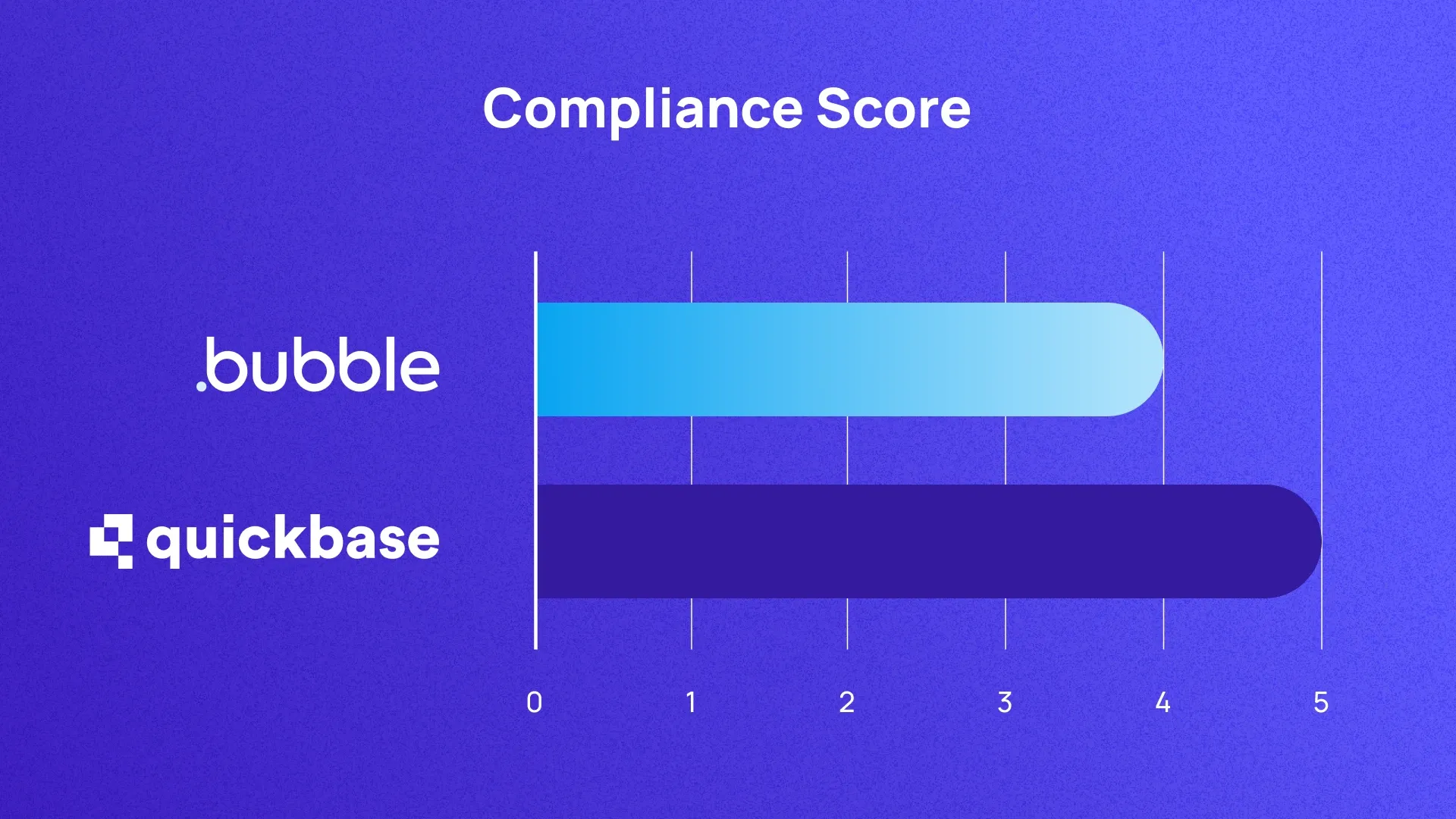
Whether you’re building an internal app or a customer-facing one, your app is going to hold a lot of data — and it’s your job to keep that data secure.
Building on a secure development platform gives you the foundation you need for a secure app. Evaluating compliance standards can establish a baseline for security capabilities, and you can often harden a platform with additional security features as needed.
Our compliance scores are based on which standards a platform complies with (by default) and whether it offers a path to compliance with additional standards. Higher scores correspond to more sophisticated standards.
Bottom line: Bubble and Quickbase both offer compliance with SOC 2 Type II. Quickbase offers higher levels of compliance on higher plan tiers, while builders on any Bubble plan can build their app in compliance with stronger regulations by taking a few additional steps.
| Score | Criteria |
|---|---|
| 1 | No stated native compliance certifications |
| 2 | No native compliance certifications, but either 1) can be made compliant with plugins or 2) gives instructions for hosted apps to become compliant by themselves |
| 3 | SOC 2 Type I compliant |
| 4 | SOC 2 Type II compliant or ISO 27001 compliant |
| 5 | SOC 2 Type II compliant and HIPAA compliant |
How Quickbase stacks up: Quickbase offers strong security and compliance standards, following SOC 2 Type II, GDPR, FDA, and HIPAA. Its focus on enterprise customers means it’s invested heavily in compliance and security, which can be a major benefit.
However, keep in mind that FDA and HIPAA compliance are only available on Business and Enterprise plans, starting at $2,200+ per month.
Quickbase’s compliance score: 5/5
How Bubble compares: Bubble offers several major compliance certifications for all users, including SOC 2 Type II. We’ve also taken a number of steps to help protect user data, and provide access to Flusk’s best-in-class security-check features.
If you need compliance with more stringent security standards, like GDPR or HIPAA, it’s possible to build compliant apps on Bubble — just follow our series of compliance articles and we’ll walk you through the process of tightening your app’s security.
Bubble’s compliance score: 4/5
Quickbase vs. Bubble on code ownership
Maybe you’re only planning on using a no-code platform for short- or medium-term projects — just quickly testing and validating ideas, perhaps. But even if you’re never planning to leave a no-code platform once you start building, it’s impossible to guarantee that you’ll never need to.
When choosing a no-code platform, it’s smart to go in knowing what you can take out. Our scoring criteria for the ownership category are based on how much freedom a platform gives you to export your work — specifically your code and your data.
Bottom line: Quickbase and Bubble both allow you to export data, but not code.
| Score | Criteria |
|---|---|
| 1 | No exports supported |
| 2 | Allows partial data exports |
| 3 | Exports data, but not code |
| 4 | Exports data and code, but in limited languages and formats |
| 5 | Exports all data and code |
How Quickbase stacks up: Quickbase allows users to export data from the app — the only catch is that you can only export data one table at a time, which can be time-consuming for larger enterprise systems. Data is exported as a .CSV file.
Quickbase doesn’t allow code exports or support app exports, so your UI and your workflows and logic can’t be exported. Though some users have suggested complicated workarounds for exporting and importing some elements of your Quickbase app into other systems, it’s certainly not a supported feature.
Quickbase’s code ownership score: 3/5
How Bubble compares: When you build on Bubble, you can always export data freely. However, it’s not possible to export code, because on Bubble, our platform’s proprietary source code powers your software, so we can’t export your code without either releasing our source code or separating it, which would break your software.
Our promise to our customers, though, is that if your organization outlasts Bubble, we’ll release our source code under an open-source license.
Bubble’s code ownership score: 3/5
Quickbase vs. Bubble on learning curve
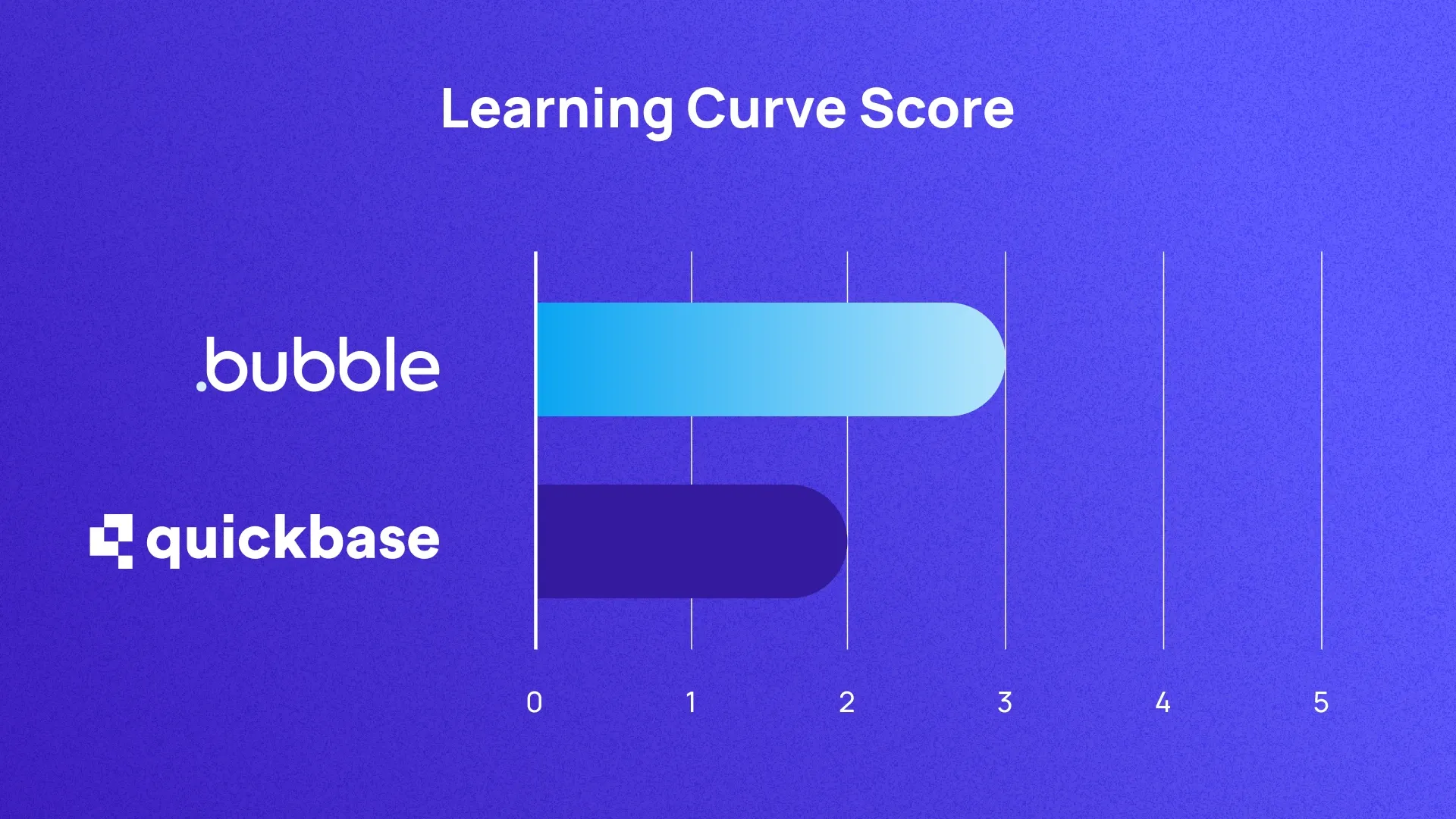
No-code development will always be easier than coding — but that doesn’t mean it’s completely effortless. After all, every skill worth having takes some time to learn and become an expert in.
Plus, every platform is going to use visual programming in different ways, so you’re going to have to invest some time into learning the platform. The question is, how much time do you need to — and are you willing to — invest. Some platforms require some technical background, while others allow you to be up and running in less than an hour.
Our learning curve scoring criteria is based on how difficult a platform is to learn and how fast you can actually start building.
Bottom line: Bubble and Quickbase both are easy to get started with, but Bubble offers a more moderate learning curve in the long run. Building complex apps on Quickbase requires some technical knowledge and often coding experience, and many users report getting stuck.
| Score | Criteria |
|---|---|
| 1 | Extremely difficult to learn (comparable to learning code), demands significant technical knowledge, extensive time investment |
| 2 | Very difficult to learn, demands strong understanding of logic and some technical familiarity, extensive time investment |
| 3 | Moderately difficult to learn, demands moderate technical familiarity, moderate time investment (courses, tutorials, community support, etc.) |
| 4 | Somewhat easy to learn, demands minimal technical familiarity, allows you to start building on your first day |
| 5 | Extremely easy to learn, no technical familiarity needed, allows you to build something in your first hour |
How Quickbase stacks up: For developers or others familiar with database systems, management, and organization, Quickbase provides a moderate and manageable learning curve. However, many non-technical users say that going beyond basic apps, databases, or automations in Quickbase is difficult — even “arduous.”
Why? Quickbase is closer to low-code than no-code, requiring code at some points for more advanced features and customizations. Also, although the basics are easy to learn, going beyond those requires knowledge of relational databases and database architecture, which can be difficult to learn. Users commonly complain that they can build basic apps, but then “hit a wall” when they need to create something more complex.
Plus, many users say that apps in Quickbase become more difficult to maintain as they grow in complexity, making it more suited to more experienced builders in the long run, or to those who are willing to tackle a steeper learning curve.
Quickbase’s learning curve score: 2/5
How Bubble compares: Bubble is incredibly easy to get started with — especially if you start with the AI app generator. Describe the app you want to build in your own words and Bubble AI will create an overview of key features. Add, remove, or edit key features as much as you want, and generate when you’re ready. In moments, you’ll have a beautiful, responsive, and functional application that’s ready for you to iterate on. So even with no experience and just a basic idea, you can start building your very own app.
But you don’t need AI to get started quickly with Bubble. Our intuitive, visual editor makes it easy to use drag-and-drop functionality to do everything from designing your pages to setting up workflows, databases, and logic to power your app’s functionality.
Of course, Bubble is an extensive platform, so learning all the ins and outs will take some time and effort. But in any case, it’s much easier than learning how to manage AI-generated custom code or building your app from scratch with traditional development! Bubble provides lots of resources and paths to learn, and our templates help you quickly turn straightforward ideas into fully-developed apps.
A technical background helps you get more from the platform, faster, but you don’t need experience to hit the ground running.
Bubble’s learning curve score: 3/5
Quickbase vs. Bubble on education and documentation resources
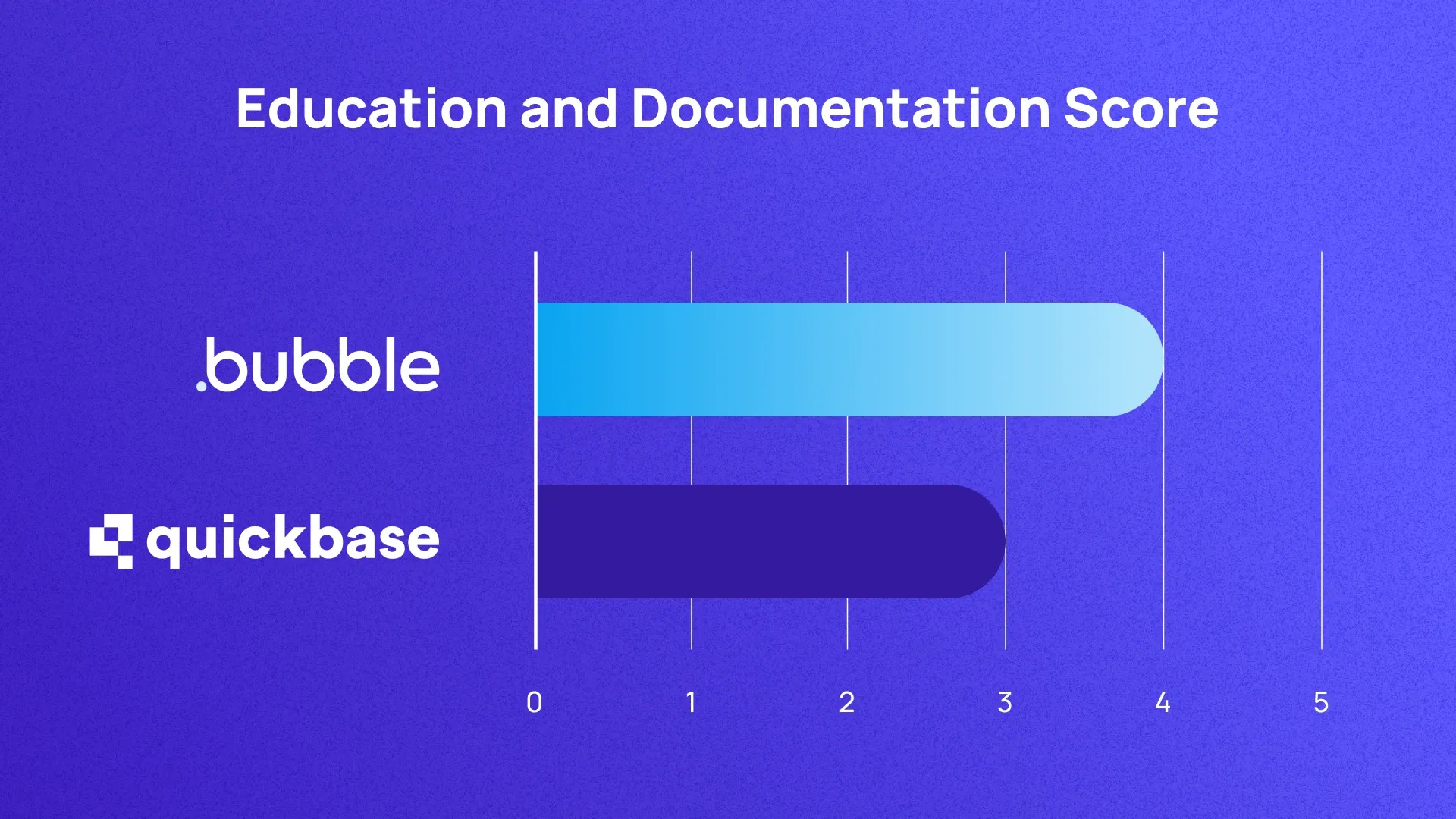
Regardless of the learning curve, the right resources and documentation can make a big difference in how easy a platform is to learn and work on (or not). A great no-code platform doesn’t just have an intuitive interface and editor — it also provides the self-guided educational resources and documentation to give you what you need to troubleshoot and learn.
Our scores for a platform’s resources are based on how much first-party educational materials it has — like guides, tutorials, and technical documentation.
Bottom line: Bubble and Quickbase both offer educational resources and technical documentation, but Bubble offers a wider variety of resources for both different skill levels and learning types.
| Score | Criteria |
|---|---|
| 1 | Low-quality educational resources |
| 2 | Medium-quality resources |
| 3 | High-quality resources, low coverage |
| 4 | High-quality resources, medium coverage |
| 5 | High-quality resources, comprehensive coverage |
How Quickbase stacks up: Quickbase offers a lot of high-quality resources, but they’re not as comprehensive as you would expect given the learning curve and complexity of the platform. They’re also quite spread out, so it can be difficult to find what you need.
That said, they do offer a lot of different entry points to learn the platform. Their primary education resources are through Quickbase University, which offers self-guided courses for those just getting started with the platform all the way through certification. You can also attend a live training session or webinar for specific skills or feature walkthroughs.
If you have more specific questions, you can check the help documentation, which gives more technical answers, but is a little sparse. Aside from the live trainings, most of their documentation is text-based as well, which can be tough if you’re more of a visual learner.
Quickbase’s education and documentation score: 3/5
How Bubble compares: Since we know Bubble is used by all kinds of builders, from technical developers to those without any technical background at all, we’ve invested in heaps of both high-level educational content and technical documentation — for all skill levels and learning types.
The result is that anyone can start building on and learning Bubble, no matter where you are in your no-code experience.
We have hundreds of videos, step-by-step building guides, self-guided courses, interactive lessons and tutorials, cohort-based bootcamps, and — of course — a comprehensive user manual for all your technical questions.
When you’re ready to become an expert on Bubble, our Bubble Developer Certification program is an excellent way to solidify your skills and get the most out of the platform.
Bubble’s education and documentation score: 4/5
Quickbase vs. Bubble on community
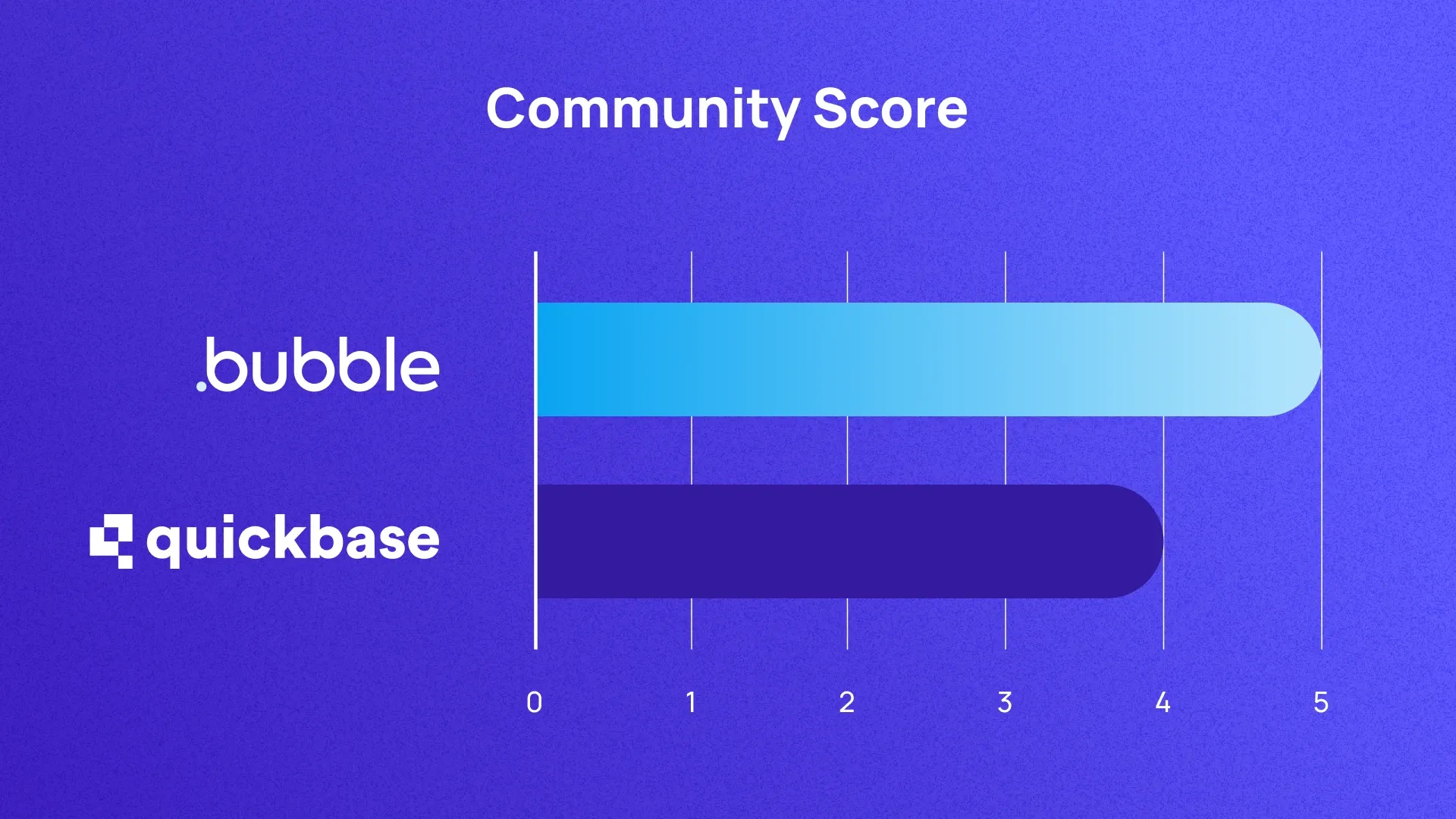
When you’re building on a new platform, the right community can make a big difference, too.
The more people involved in the platform’s community, and the more engaged and tight-knit they are, the more likely you are to get the recommendations, tips, and feedback you need.
It’s also worth asking: Is the vendor part of that community? The more actively involved vendors are in the communities that form around their platforms, the more aware they are of users’ needs and sentiments — and the more access you have to the people who make decisions about the platform.
Our scores reflect how active a platform’s developer community is and the degree to which the platform vendor participates in the community.
Bottom line: Bubble and Quickbase both offer robust communities, with access to other developers and builders and the company.
| Score | Criteria |
|---|---|
| 1 | No community channels |
| 2 | Community channels exist, but participation is low |
| 3 | Active community, some company participation |
| 4 | Robust community, regular and valuable company participation |
| 5 | Everything in 4, plus in-person company events |
How Quickbase stacks up: Quickbase has a robust community, which it calls “The Qrew.” You can connect with other Quickbase users and builders most actively on the company forums, which are fairly active and see decent engagement.
They also offer Qrew groups, which are location-, industry-, or topic-based discussion groups that sometimes host member-led meetups, in-person or virtually. If you have questions or need feedback or support, you can join a specialized Qrew, ask a question in the general forums, or reach out directly to Quickbase’s support team.
Quickbase’s community score: 4/5
How Bubble compares: Bubble’s developer community is one of our greatest strengths.
Not only do we host a highly active forum where posts regularly see thousands of views and hundreds of comments, but Bubble users are also active on multiple subreddits, Discord groups, WhatsApp, Slack, Facebook, and more. Wherever you like to hang out online, you can expect to find a tight-knit and supportive group of Bubble builders there.
What’s more, since Bubble is such a versatile and open-ended platform, you’ll find builders in our communities from all over the world, both developers and non-technical builders, founders and hobbyists, and folks from all kinds of industries — offering you plenty of support and a range of folks to bounce ideas off of.
The Bubble team also hosts in-person and virtual events, as well as our annual BubbleCon. And when there are important announcements, we make sure to share them with our followers on X and LinkedIn, too.
Bubble’s community score: 5/5
Bubble vs. Quickbase: Which one is for you?
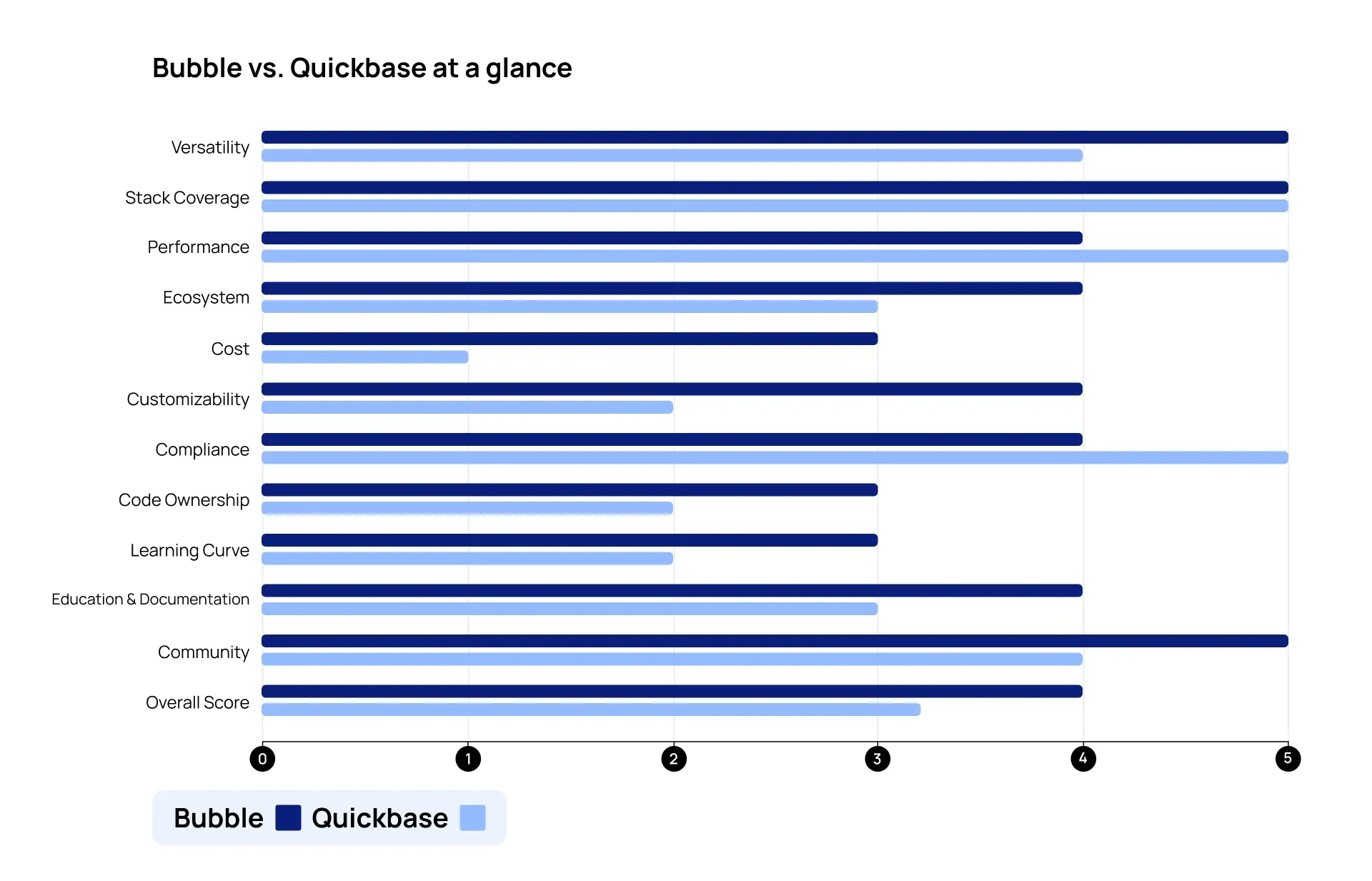
Bubble and Quickbase are both full-stack, no-code development platforms that offer strong performance, compliance, and community support. However, Quickbase is designed for a more narrow subset of industries and use cases, while Bubble provides a flexible, customizable solution that can be used for a nearly unlimited number of projects.
Quickbase offers a good solution for enterprise teams who have a massive database, a big budget, and are willing to rely heavily on custom code to create internal tools to track and optimize specific business processes. Quickbase provides visual, interactive data management with the option to use custom code for more robust tools, and a solid way to build apps and dashboards for data entry and reporting.
However, its expensive price, limited customizability, and steep learning curve make it prohibitive for many use cases and teams. In particular, the steep learning curve means that many non-technical builders find themselves hitting a wall once they try to go beyond the basics.
Bubble, on the other hand, offers a flexible, versatile platform with complete customization to allow anyone to build apps of any kind and maintain complete control. Bubble offers significantly more customization and use-case versatility, with less of a learning curve, which means you can be building more complex apps, faster. Plus, Bubble’s affordable cost and scalable platform means you can build any type of app — from internal tools and enterprise-grade solutions to SaaS startups, consumer- or client-facing apps, and more.
Bubble also makes it easier to build custom apps with advanced features and user interfaces. Complete customization means you can build your tool with any functionality and design it any way you like — down to the pixel. Plus, Bubble offers a much stronger (and more accessible) ecosystem, both in terms of plugins and integrations, and educational resources.
Bubble is for everyone — from non-technical founders and builders to experienced developers alike. You can use custom code — or not. You can start from a template, use Bubble AI to help you build, or start from a blank slate. You can take a course to get started, or dive in on your own and use our manual for support when needed.
The choice is always yours. Bubble’s flexible platform is versatile enough to meet the needs of all of our users, team sizes, industries, and app types, so no matter what you’re dreaming up, you can build it on Bubble.
Want to see how Bubble compares to other no-code platforms? Check out some of our other comparisons:
Choose the no-code development platform that’s right for you
The no-code platform you choose completely shapes what your products and tools can actually do, the speed with which you can bring them to market, the ongoing impact development has on your budget, and the experience you’ll have for years to come.
Want to learn more about what goes into choosing a no-code development platform, along with a more detailed breakdown of the choices available to you? Check out our buyer’s guide to no-code development platforms.
The best way to decide which no-code platform is right for you? Try them yourself. You’ll see the difference, especially if you start with these comparisons in mind.
Build for as long as you want on the Free plan. Only upgrade when you're ready to launch.
Join Bubble






